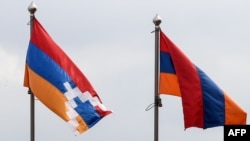After six days of heavy fighting over Azerbaijan’s breakaway region of Nagorno-Karabakh, Baku’s forces appear to be trying to consolidate control over a series of abandoned towns and villages they claim to have retaken around the ethnic Armenian-held capital, Stepanakert.
Matthew Bryza, a former U.S. ambassador to Azerbaijan and former U.S. cochair of the OSCE's Minsk Group, says that battle plan would be in line with the political goals of President Ilham Aliyev.
“I think the Azerbaijani objectives here are limited,” Bryza tells RFE/RL. “They are political, largely. Recapture some territory that they can hold without going too far and find themselves being overextended.
“This is exactly what I’d expect Azerbaijan to do,” Bryza says. “War is the continuation of politics by other means. You go to war because you have political objectives.”
The Minsk Group is tasked with negotiating a resolution between Armenia and Azerbaijan over Nagorno-Karabakh.
Azerbaijan and Armenia have been locked in a conflict over the mountainous region since the waning years of the Soviet Union. They fought a war that ended in 1994 with an uneasy cease-fire and an estimated 30,000 killed. Since then, Nagorno-Karabakh has been under the control of ethnic Armenian forces.
Bryza, who was the U.S. ambassador to Azerbaijan from 2010-2012 and the U.S. deputy assistant secretary of state for European and Eurasian affairs from 2005-2009, says the main political objective for Aliyev is “to regain some territory, enough territory, so that his historical legacy will be positive.”
“[If he's successful, he] will have enabled several hundred thousand displaced Azerbaijanis to return to their homes,” which have been abandoned since the early 1990s. "That is an enormous political achievement," says Bryza, who is now a senior fellow at the Atlantic Council think tank.
For the most part, Bryza concludes, the long-abandoned villages Baku claims to have “liberated” to the southeast of Stepanakert during the past week are in “territory on the flatlands up to the base of the hills” around Nagorno-Karabakh’s capital.
An advance by Azerbaijani forces to retake Stepanakert would have to cross treacherous hilly terrain, as well as deep gorges with steep cliffs.
“They appear to have captured the territory on the flatlands because that is what they could capture the easiest,” Bryza says. “But it’s also the hardest for them to hold.”
“From Azerbaijan’s perspective, the fighting will need to continue into the higher ground like it has in the north so that Azerbaijan will be able to defend that territory it has gained,” he adds.
It’s actually the Armenian side that has the preconditions to talk. Not Azerbaijan."-- Former Baku Ambassador Matthew Bryza
Ultimately, Bryza -- who as the deputy assistant secretary of state for European and Eurasian affairs in 2005-2009 was responsible for all the South Caucasus countries as well as Turkey, Greece, and Cyprus -- thinks Azerbaijan is “positioning to be able to go back to negotiations” under international mediation, with Russia eventually prodding the Armenian side to rejoin the talks.
“I don’t think Azerbaijan wants to go much beyond this, consolidating its hold on these retaken territories,” Bryza explains. “The further it goes, not only is it more expensive and riskier, but their supply lines are extended and the whole operation becomes much more complicated.”
“They possibly could draw a reluctant Russia into the conflict if the fighting went way too far and into Armenia,” he says. “So I would expect them to keep fighting for a while, consolidate the territory that they’ve apparently gained, and then go to negotiations.”
Bryza says he expects to hear Baku “echo statements” made by the presidents of Russia, the United States, and France to “go back to negotiations with no preconditions.”
“It’s actually the Armenian side that has the preconditions to talk. Not Azerbaijan,” he says.
If there are mass casualties, mediators will have a much harder time containing the fighting."-- Olesya Vartanyan, International Crisis Group
Other experts agree that a further escalation of fighting, such as an attempt by Azerbaijani forces to storm into Stepanakert, would make it harder to get negotiators back to the table.
“Artillery, rockets, and drones have struck populated areas located close to the front line and deeper inside the Nagorno-Karabakh conflict region,” says Olesya Vartanyan, an analyst on the South Caucasus region for the International Crisis Group. “Fearing air strikes, Stepanakert -- a city of 55,000 people -- has gone dark. People have taken refuge in basements and shelters. If fighting escalates, more will be at risk.
“There are hundreds of thousands of people living close to the front line,” Vartanyan says. “If there are mass casualties, mediators will have a much harder time containing the fighting, and the risk of foreign military intervention also rises.”
Reports by Armenian and Azerbaijani defense officials show that a total of more than 200 people -- civilians and soldiers -- have been killed and many hundreds of others injured so far in the latest conflict.
Many thousands of others have fled their homes, with many residents of Nagorno-Karabakh seeking refuge in Armenia.
Military Objectives
Azerbaijan’s military strategy so far has focused on two key fronts around Stepanakert, as well as a strategic mountain range to the northwest of the city.
To the southeast, Baku’s forces have been fighting for a low-lying river valley and foothills in the districts of Cebrayil/Jrakan and Fuzuli/Varanda.
“There had been a couple hundred thousand people that had lived in the whole district of Fuzuli before the war happened,” Bryza explains. “The Cebrayil district was not as populated, but if you can get several hundred thousand displaced Azerbaijanis to be able to return to their homes, that’s a very large political achievement for President Aliyev.”
Directly north of Stepanakert, Azerbaijan’s troops are positioned at the heavily fortified approaches into Nagorno-Karabakh.
Statements from both Yerevan and Baku confirm heavy fighting there in the divided district of Tartar and in parts of Nagorno-Karabakh’s northern district of Martakert.
Meanwhile, there have been competing claims about fighting in the Murovdag/Mrav mountains to the northwest.
That mountain ridge -- controlled by ethnic Armenian forces since Nagorno-Karabakh’s shaky 1994 cease-fire -- has enormous strategic significance. That’s because it overlooks and runs parallel to the only road linking Yerevan directly with the northern part of Nagorno-Karabakh.
Known as the Vardenis-Martakert Highway, the road was destroyed during the war in the early 1990s. But it has reopened in recent years as a crucial link through occupied territory of Azerbaijan after being rebuilt using funds from the Armenian state budget.
If it’s true that the Martakert-Yerevan road has been cut off [by Azerbaijan], that’s very significant."-- Matthew Bryza
When the fighting erupted on September 27 with artillery barrages and drone strikes, Azerbaijani Defense Ministry spokesman Anar Eyvazov claimed Baku’s forces “destroyed a number of posts of the occupiers and took control of dominant heights” along the Murovdag ridge.
But Stepanakert’s de facto defense officials reject claims that Azerbaijan’s army has taken control of the heights overlooking the Vardenis-Martakert highway. They have called the report an “information provocation of the Azerbaijani propaganda machine.”
“If it’s true that the Martakert-Yerevan road has been cut off [by Azerbaijan], that’s very significant,” Bryza says. “The only other major connection between Armenia and Nagorno-Karabakh is through Armenia’s southern region of Lachin -- the so-called Lachin corridor. If that’s the only route, then Nagorno-Karabakh is really in a vulnerable situation.”
Bryza -- who lives in Istanbul and is on the board of the Turkish energy firm Turcas Petrol -- says video footage shared by Baku’s Defense Ministry from the southeastern Ceybrayil-Fuzuli front suggests Azerbaijan has significantly bolstered its military capabilities in recent years through the purchases of weaponry, mainly from Russia, but also from Israel and Turkey.
“The footage near Fuzuli shows the Azerbaijani side was able to destroy at least one battery of S-300 air-defense missiles that are possessed by Armenia but are jointly operated by both Russia and Armenia,” Bryza tells RFE/RL.
“What that shows is that Azerbaijan took a very bold step -- if it’s true -- to even risk a confrontation with Russia in this situation,” he says.
“It’s not easy to knock out those anti-drone and anti-missile systems with a drone or a missile,” Bryza explains. “So Azerbaijan appears to have shown a high degree of capability in that situation.”


















